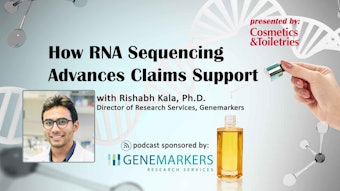
(For the complete article, click through to the May 2019 digital edition.)
You may have heard of King Arthur, with his interminable search for the holy grail. In one film renditiona, the secret of the grail is simply that the land and Arthur are one. As one thrives, so does the other and, unfortunately, as one suffers the other suffers as well. It is a wonderful illustration of interdependence, in which changes to one partner in a relationship can significantly impact the other.
What does any of this have to do with skin care? Quite a bit, when you closely examine the interrelationship between the dermal layer of the skin and its main constituent cell type—the dermal fibroblast.
The dermal layer of the skin consists of densely packed extracellular matrix (ECM) components, such as collagen and elastin proteins, which provide the structural strength and elasticity to skin; alongside glycosaminoglycans, proteoglycans and glycoproteins. Of all of these components, collagen is by far the most abundant and comprises about 90% of the skin’s dry weight, with type I collagen being the predominate type.1
As is well-understood, the main source of production for all of these ECM components is dermal fibroblasts, with the rate of production controlled by various hormonal, autocrine, paracrine and physical factors. Indeed, increasing the production of these ECM components is one of the main targets for cosmetic active ingredients, as the inevitable reduction in their production, e.g., due to aging and sun exposure, is associated with the undesirable fine lines and wrinkles, as well as sagging and thinning skin, which drives our industry. Unfortunately, though, the focus is too often targeted on the fibroblast alone as experiments are planned. We assume the process flows in a single direction: active ingredients stimulate the fibroblast and in return, the fibroblast makes more of the target ECM component and the ECM component makes its way into the ECM—end of process.
This is essentially how it works in most in vitro experiments, and it is a good model to screen for in vivo efficacy in younger individuals. However, the process becomes vastly more complicated with both chronological aging and sun exposure. Under these conditions, the ECM becomes damaged, and this damage in the ECM can have a feedback effect on the fibroblast. This can produce drastic and adverse consequences on the fibroblast, such as stimulating an increase in MMP production; shutting down collagen synthesis pathways; and even driving the fibroblast into an early senescence.2 In essence, the damaged ECM signals the fibroblast to not only shut down the pathways responsible for synthesizing the ECM components, but also to become unresponsive to any stimuli that would turn these pathways back on. This list of stimuli could potentially include cosmetic actives, in which case the efficacy of an active could decline as the age of the user increases.
So what is the type of ECM damage associated with these adverse effects on fibroblasts? And can it be prevented or countered?
Collagen Fragmentation
One of the more prominent forms of ECM damage occurring with aging and sun exposure is collagen fragmentation. The initial driving mechanism is thought to be caused by ROS formation.3 With chronological aging, intracellular ROS formation occurs slowly but steadily over time as a result of normal cellular functions, such as mitochondrial metabolism. In contrast, ROS formation can be rapidly and quite significantly increased with UV exposure. Unfortunately, the skin that undergoes both chronological aging and is exposed to UV can experience the additive effect of both ROS sources.
Continue reading in the May 2019 digital edition...











